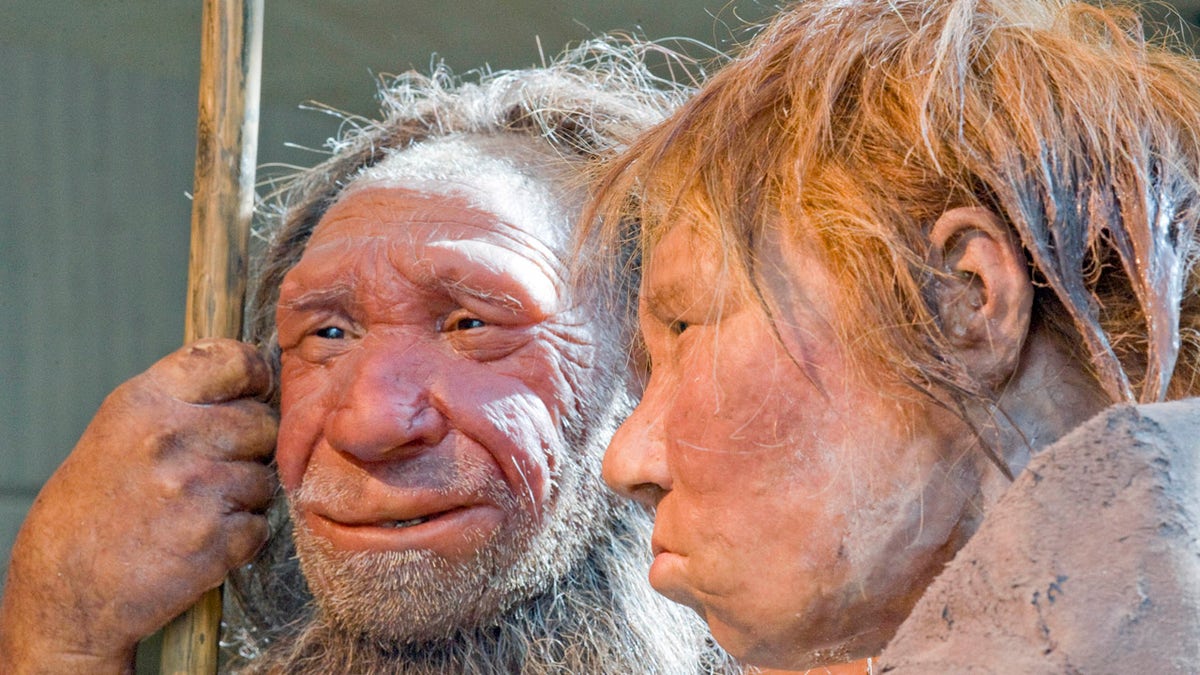
FILE - This Friday, March 20, 2009 file photo shows reconstructions of a Neanderthal man, left, and woman at the Neanderthal museum in Mettmann, Germany. (AP Photo/Martin Meissner)
Many people around the world have more Denisovan DNA than previously thought, which has contributed to their sense of smell and ability to thrive at high altitudes, according to a study released Monday.
Researchers know that modern humans with ancestry outside of Africa inherited up to 2.1 percent of their DNA from Neanderthals. But far less was known about Denisovans, who are believed to have shared origins with Neanderthals and account for up to 5 percent of DNA in some present day populations.
The latest work, from a research team at Harvard Medical School and UCLA, developed a world map of ancient DNA. In doing so, they found that populations in Oceania populations had the highest percentage of ancient DNA – 2 percent Neanderthal and 5 percent Denisovan - while South Asians had more Denisovan DNA – 0.1 percent in Sherpas - than expected. That raises the possibility of unknown interbreeding events.
Western Europeans are the least likely non-Africans to have Neanderthal or Denisovan DNA while Africans have almost none.
Related: DNA from mysterious 'Denisovans' helped modern humans survive
“It’s a very comprehensive look at how the modern human population evolved, how we got to where are today,” UCLA’s Sriram Sankararaman, a co-author on the study that appeared in Current Biology, told FoxNews.com. “You need to be able to understand our interaction with these archaic populations. These interbreeding events introduced very different genes into modern humans so a major question for us in human genetics is to figure out what has been the impact of these genes.”
Researchers also found this inherited DNA has benefited modern humans, in good and bad ways – building on earlier research that, according to Live Science, found Denisovan DNA had boosted modern humans’ immune system and helped them survive.
Denisovan genes were found to contribute to a more subtle sense of smell in Papua New Guineans and contributed to adaptions to high-altitude in Tibetans. Neanderthal genes most likely contribute to tougher skin and hair.
"There are certain classes of genes that modern humans inherited from the archaic humans with whom they interbred, which may have helped the modern humans to adapt to the new environments in which they arrived," David Reich, a geneticist at Harvard Medical School and the Broad Institute and a co-author on the paper, said in a statement. "On the flip side, there was negative selection to systematically remove ancestry that may have been problematic from modern humans. We can document this removal over the 40,000 years since these admixtures occurred."
Related: Prehistoric tooth reveals surprising details about long-lost human 'cousins'
The most obvious downside to inheriting the ancient DNA, the researchers found, was the potential for increased infertility – a common problem when species interbreed. As a result, the researchers found evidence that both Denisovan and Neanderthal ancestry had disappeared from the X chromosome as well as genes expressed in the male testes.
“We see a lot less compared to the rest of the genome,” Sankararaman said.
“You’re going along the genome and there is the X chromosome or there are genes expressed in testes. Basically, these parts of the genome have less Neanderthal or Denisovan,” he said, adding that there “was very strong pressure to remove the bad copies of these genes.”
Evolutionary geneticist Svante Pääbo at the Max Planck Institute for Evolutionary Anthropology at Leipzig, Germany, who has shown that Neanderthals and humans first mated around 50,000 years ago, praised the study.
Related: Neanderthal woman's genome reveals unknown human lineage
“I think this is a very cool study. It is especially interesting that just as the genetic interactions with Neanderthals in Europe and western Asia seem to have been numerous and contributed some important gene variants to present-day people, in eastern and southern Asia similar things seem to have gone with the Denisovans,” Pääbo told FoxNews.com, via email.
“It is cool that Neanderthals and Denisovans are not totally extinct. Parts of them live on in people today,” he added.
The researchers collected their data by comparing known Neanderthal and Denisovan gene sequences across more than 250 genomes from 120 non-African populations publically available through the Simons Genome Diversity Project. The analysis was carried out by a machine-learning algorithm that could differentiate between components of both kinds of ancestral DNA, which are more similar to one another than to modern humans.
While they can learn much from this interbreeding, researchers cautioned against drawing any conclusions based on the DNA about the movement of populations or the possible traits left behind by our ancient ancestors.
"We can't use this data to make claims about what the Denisovans or Neanderthals looked like, what they ate, or what kind of diseases they were susceptible to," Sankararaman said. "We are still very far from understanding that."
The research study can be found here.